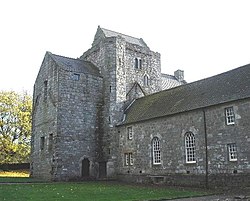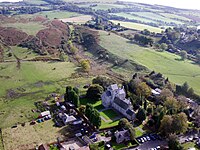Torphichen Preceptory
| Torphichen Preceptory | |
|
West Lothian | |
|---|---|
 Torphichen Preceptory | |
| Location | |
| Grid reference: | NS96967255 |
| Location: | 55°56’6"N, 3°39’4"W |
| Village: | Torphichen |
| History | |
| Address: | The Bowyett |
| Built 1140s | |
| Information | |
| Owned by: | Historic Scotland |
| Website: | Torphichen Preceptory |
Torphichen Preceptory is a mediæval building in the wee village of Torphichen in West Lothian which served as the mediæval headquarters of the Order of Knights of the Hospital of Saint John of Jerusalem, the Knights Hospitaller, in Scotland. Today it is co-located with the village church, Torphichen Kirk: the church has the nave of the old Hospitaller church while the rest of the building, which has been used for other purposes over the ages, is in the care of Historic Environment Scotland.
Torphichen Preceptory was founded by David I in the 1100s. It was the Scottish base of operations for the order's work. The Hospitallers were warrior-monks, originally tasked with sheltering and protecting pilgrims in the Holy Land, but becoming a serious military force which took part in many of the great battles of the Crusades. The Order's preceptories across Europe and in Britain were estates granted to the Order to collecting lucrative rents. While the Knights Templar became an order so wealthy that they were eventually suppressed in most of Europe and their estates confiscated, the Hospitallers survived until the Reformation.
The buildings today comprise the remains of the mediæval preceptory. Much of what we see today was built in the 1400s. Only a precious fragment of the knights’ house remains, but there are a few remarkable survivals, such as the ribbed vault etched into the south transept wall and a remarkable painted wall decoration.
History
King David I granted the estate at Torphichen in the early twelfth century; one of many monastic foundations by that King in his southern shires. This place was at the meeting point of three languages, Old Welsh, Old English and Gaelic, and the name 'Torphichen may be in origin Gaelic , from Tóir Féichín ('the boundary/sanctuary of St Féichín') or Welsh, tref fechan ('Little town'). A Gaelic origin has been lately preferred in reference to Sanctuary stones set at a one mile boundary around the village.
The Preceptory was built in the 1140s around an existing church, possibly of early Christian origin. During the 13th Century the Preceptory was expanded, and the buildings which still stand were first erected. The complex included a cruciform church, with a nave, central tower, transepts and choir, whose tower and transepts remain, and a number of domestic buildings including a hospital. The church was extended again in the 15th Century, and a cloister completed, of which only the foundations remain. Very unusually, this was situated on the north side of the church (a feature seen elsewhere in Scotland only at Melrose Abbey).
The preceptory answered to the priory in Clerkenwell in London, and consequently in the wars that rent Great Britain in the Middle Ages, the Hospitallers were aligned with the English. William Wallace occupied Torphichen in 1298.
Wallace held his last parliament here, prior to the battle of Falkirk (1298)|Battle of Falkirk in 1298. The only surviving document signed by Wallace as Guardian of Scotland, Custos Regni Scotiae, was prepared here.[1] After the battle, King Edward I of England was brought to the Preceptory for treatment of the injuries caused when his horse stood on him, whilst he was encamped at Polmont before the battle.
The Hospitallers fought on the English side during the Wars of Scottish Independence, and withdrew after the Scots victory at Bannockburn, returning during the rule of Robert the Bruce.
The preceptor, Sir William Knollys, served as Lord High Treasurer of Scotland for James III and James IV, was created Lord St John of Torphichen, and is commonly held to have died at the Battle of Flodden in 1513.
The last Preceptor was Sir James Sandilands, was the second son of James Sandilands, Baron of Calder. Sir James's father and elder brother John had both backed the Lords of the Congregation and were friends of John Knox. In February 1564 Sir James surrendered the Preceptory lands to the Crown, this being in the reign of Mary, Queen of Scots, whereupon she gave the lands back to him for a payment of 10,000 crowns, with the secular title Lord Torphichen.[2]
The honorary post of Preceptor of Torphichen continues to be used within the modern day Order of St John of Jerusalem, a Georgian reinvention of the Order which is now established by Royal Charter.
After the Reformation, the nave of the Preceptory church was converted for use as the parish kirk, with the rest of the buildings falling into disrepair. Nevertheless, the surviving crossing of the church (below the central tower) retains some of the best-preserved late 12th-early 13th century masonry in Scotland, with refined architectural detail. In 1756 the nave and domestic buildings were demolished, and a new T-plan kirk built.
The remnants of the Preceptory were used as a courthouse for a number of years. The central tower was re-roofed in 1947 and is now in the care of Historic Scotland (open in summer, with an entrance charge).
About the building

A 'sanctuary stone' in the kirkyard marks the centre of an 'area of sanctuary' that once extended one Scots mile around. The east and west 'sanctuary stones' still stand in their original positions. It has been suggested that these stones are of much earlier origin than the mediæval Preceptory, possibly being related to the important Neolithic henge and burial mound at Cairnpapple Hill, to the east.
The large kirkyard has a fine collection of 17th–18th century headstones, with much intriguing 'folk art', including symbols of mortality, tools representing professions etc.
Outside links
- Torphichen Preceptory - scheduled monument detail (Historic Environment Scotland)
- Torphichen on Undiscovered Scotland
- Information from the West Lothian Archaeology Group
- Information from Rootsweb
- Information from Gazetteer of Scotland
- Torphichen Community and Heritage
References
- Cowan, Ian B., Mackay, P. H. R., & Macquarrie, Alan (ed.,): 'The Knights of St John of Jerusalem in Scotland' (Scottish History Society, 1983)